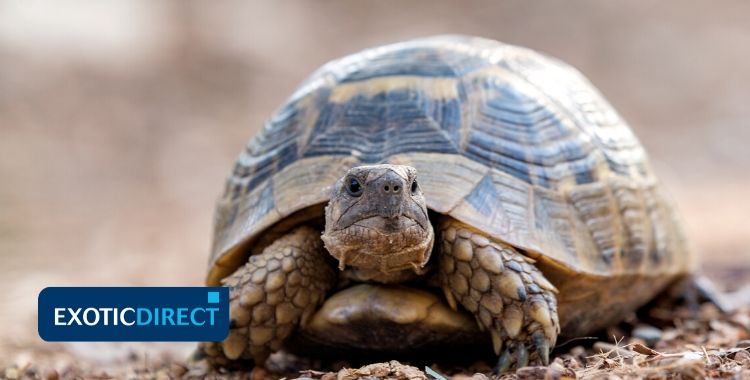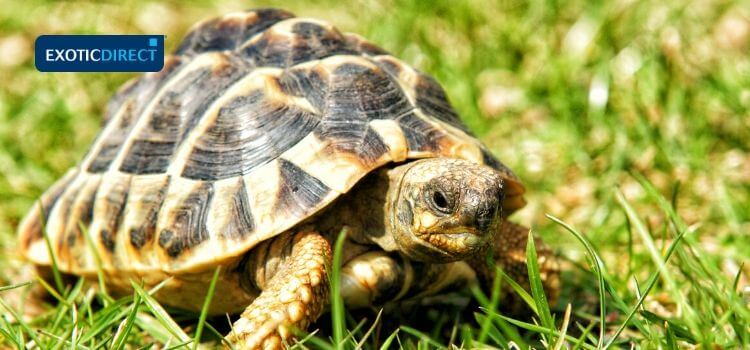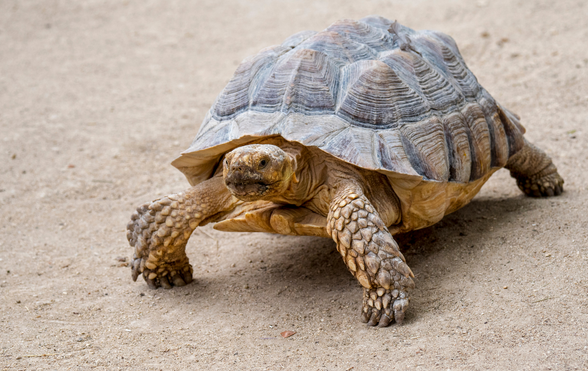From shedding skin to fly strike. The skin problems that tortoises can face, and what you can do to prevent them.
Is your tortoise insured? Get a quote for £2,500 of vet fees, death and theft cover. Vet fee cover only also available | We’ve been insuring exotic pets since 1996 | Check out our customer reviews on Feefo.
As with many reptiles, tortoises have scaly skin, particularly in vulnerable parts of their body, such as on the front of their forelegs. Other areas of skin better protected by the shell, such as the groin lying above and in front of the hind legs for example, are thinner and lack any large horny scales.
The skin itself serves to protect against dehydration and forms a barrier against bodily infection.
Seen in cross-section under a microscope, the tortoise’s skin (like ours) is made up of a series of layers. The top layer of skin is effectively dead, and wears away over time, being replaced by fresh skin from beneath.
 Tortoises have scaly skin on their forelegs for protection
Tortoises have scaly skin on their forelegs for protection
Skip to:
- Problems affecting the skin
- Breeding injuries
- Fly strike in tortoises
- Do tortoises get ticks?
- Abscesses
- Superficial skin infections
Is your tortoise insured? Get a quote for £2,500 of vet fees, death and theft cover. Vet fee cover only also available | We’ve been insuring exotic pets since 1996 | Check out our customer reviews on Feefo.
Do tortoises shed skin?
You may sometimes notice areas of flaky, whitish areas of skin on parts of your tortoise’s body. Don’t be tempted to pick these off, as they won’t be upsetting your pet and there is a risk that you could cause a skin injury.
The best thing to do is to let nature take its course, and if you bath your pet in a shallow, tepid container of water regularly, then these loose pieces of skin will separate off naturally.
Unlike snakes which shed their entire skin in one piece, in the case of tortoises, old skin comes off in pieces.
Bathing has the additional advantage that it also provides an opportunity for your tortoise to drink, as some individuals can be reluctant to drink from a small container
 Tortoises can injure themselves through climbing
Tortoises can injure themselves through climbing
Problems affecting the skin
Thanks to their shell and horny skin protection on the vulnerable parts of their legs, tortoises are well-protected against skin injuries. But if you keep your pet confined in a run in the garden to protect against the risk of foxes and seagulls you could find that your pet tries to put its foot through the mesh
If this is done repeatedly, the tortoise will likely rub the skin and cause injury, most likely to the legs. This situation that can be avoided by using narrower mesh that your tortoise can’t put his foot through.
In garden surroundings, particularly in summer, tortoises such as Hermann’s sometimes develop a desire to wander in search of a mate, with Horsfield’s tortoises (Agrionemys horsfieldii) in particular being very determined climbers.
In this case, if they decide to climb up a chain-link fence, they can again cut themselves typically in the vicinity of the axillary region (equivalent to our armpits), as they haul themselves up.
They may also injure the larger scales on their forelegs, sometimes even losing some of these, which may cause bleeding.
Applying pressure with a damp piece of cotton wool should help to stimulate the clotting process, with a veterinary check-up being advised afterwards.
Breeding injuries
Certain male tortoises can be very exuberant in their courtship, particularly in the case of smaller individuals seeking to mate with significantly bigger females. This probably reflects the fact the female could soon outpace her suitor, and disappear off into the distance.
The male therefore bites determinedly at her legs, to slow her down, allowing him to have the opportunity to mate. This is not uncommon behaviour in Hermann’s tortoises (Testudo hermanni).
Although these reptiles have no teeth in their mouth, the edges of their jaws are sharp, enabling them to cut through tough vegetation without difficulty. The way in which a particularly aggressive male will snap repeatedly at a female can in turn give rise to what are usually relatively superficial skin injuries.
If bleeding results, then the tortoises must be separated for a period, to allow the injury to heal, with treatment as advised by your vet. The good news is that in contrast to injuries affecting the shell a tortoise’s skin usually heals quickly.

Fly-strike can be life threatening to tortoises
Fly strike (Myiasis) in tortoises
It is important that you lift up your tortoise and examine it every dayespecially if your pet is roaming outdoors during the summer.
It is not just a matter of checking for any signs of skin damage, but also for signs of loose stools and fly strike.
When tortoises such as Hermann’s, Horsfield’s and Mediterranean spur-thighed (Testudo gracea) are allowed outside in the springthere is a risk their droppings will be looser than normal at first, and this in turn may cause soiling of the skin around the tail.
The faecal matter here is likely to attract blowflies to this area, where these flies will lay their small creamy-white eggs, which look a bit like very small, miniature cigars clustered together, often sometimes attached to the edge of the shell too.
The larvae which hatch rapidly from the eggs are maggots and they will start to bore directly into the skin of the tortoise. As they do so, they release potentially deadly toxins, which are carried in the blood to the tortoise’s heart and other organs and are likely to cause rapid death as a result.
This condition – described as fly strike or myiasis – requires very rapid treatment. The maggots will need to be removed with tweezers, and the affected area of skin must be cleaned carefully and perhaps treated with antibiotic powder, to minimise the risk of infection.
Should you spot that your tortoise has been affected by fly strike, you should immediately i get your pet to avet, preferably a reptile specialist,as fly strike is potentially life threatening.Fluid therapy can also be administered if required, in the hope of overcoming the toxins that may have entered your tortoise’s system.
Do tortoises get ticks?
These can crop up on tortoises, clustering around the areas where the skin is thinnest, in the vicinity of the legs where they join the body and along the shell line.
Ticks can vary significantly in size, depending whether or not they have fed, but they are generally a brownish colour, anchoring themselves into the skin and feeding through their mouthparts. As they do so, so they start to swell in size and can become correspondingly much bigger.
Ticks are not only likely to transmit infections when they feed, but if removed carelessly it can result in their mouthparts remaining lodged in the tortoise’s skin, so these decapitated remains may then become a focus of infection as well.
Ticks therefore need to be removed carefully. This can be achieved by using a special tick-removal tool, or alternatively, simply by smearing petroleum jelly (sold as Vaseline®) over the body of the parasite.
Abscesses
There is always a slight risk that tortoises may injure themselves wandering around in the garden. The area around an injury can then become infected if bacteria penetrate into the skin, and there can be an associated swelling.
Always check your tortoise regularly for any unexplained lumps and bumps that arise on the skin, as these can therefore be signs of a localised infection here, known as an abscess.
Strangely perhaps, the most likely location for abscesses in tortoises is generally around the skin on the side of the head.
Although they do not have external ears, there is an auditory opening behind the eyes on each side of the head. If your tortoise develops a swelling here, this is almost certainly a sign of an auditory abscess.
The abscess will have to be removed surgically by your vet. The area will need to be opened up so the pus can be extracted. It is not liquid, but has a cheesy-like, semi-solid consistency.
The whole area here must be cleaned thoroughly afterwards, to kill off any harmful bacteria. In some cases, a swab may be taken and an antibiotic culture test carried out, to see which antibiotic is likely to be most effective in treating the infection.
The resulting surgical wound is not normally sealed, but allowed to heal naturally, allowing treatment at the site of the abscess to continue as required.
With any localised infection that develops in the body, there is always a risk that the bacteria responsible may enter the blood stream, causing septicaemia and giving rise to what is described as a generalised infection. This can be rapidly fatal, overwhelming the body’s natural defences, and explains why it is important to get rid of any possible lingering focus of infection here.
Superficial skin infections
Various non-specific names are used to describe skin infections of this type in tortoises, reflecting the symptoms rather than the cause. They include terms like ‘blister disease’, which refers to blister-like swellings on the skin. These can, if left untreated, burst and then cause ulceration of the underlying skin layers, giving rise to what may subsequently be called skin rot.
The description of scale rot may be used as an alternative, when the skin around the scales is affected.
From a veterinary viewpoint, these are all symptoms of the disease known as ulcerative or necrotic dermatitis, and the basic cause in all cases is usually a bacterial infection, although fungi can also be involved.
Rapid veterinary treatment is the way to overcome the problem, combined with raising the tortoise’s environmental temperature so as to help its immune system combat the disease.
So-called scale rot is most likely to affect the prominent scales on the outer surface of the tortoise’s front legs. Infections of this type as usually the result of trauma, which allows bacteria to gain access to this part of the body, ultimately leading to the loss of the scales.
There is always a danger that once again, septicaemia could follow, so do not delay in seeking veterinary advice.
When trauma alone is the cause of the lost scales, the loss is very sudden, and there may be bleeding evident too. Dabbing the affected area with a special iodine-based wound cleanser for reptiles can be helpful, both in facilitating the healing process and also to help reduce the likelihood of any infection developing.
Ultimately over time the chances are that the scales will grow back, providing the injury was not too serious.
Is your tortoise insured? Get a quote for £2,500 of vet fees, death and theft cover. Vet fee cover only also available | We’ve been insuring exotic pets since 1996 | Check out our customer reviews on Feefo.

